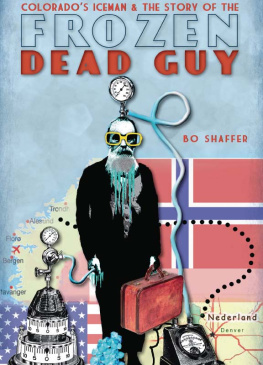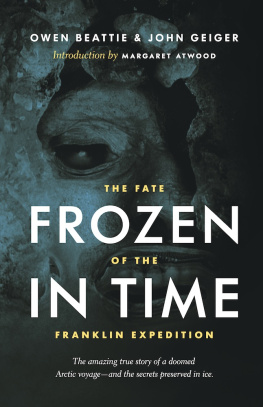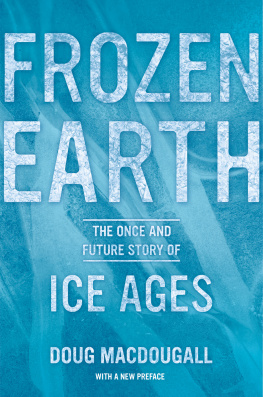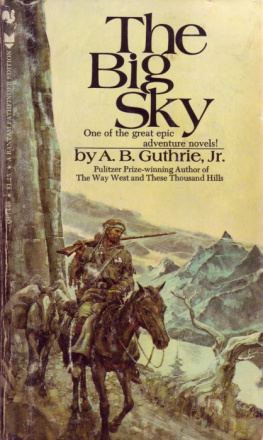The University of Chicago Press, Chicago, 60637
The University of Chicago Press, Ltd., London
1990 by The University of Chicago
All rights reserved. Published 1990
Printed in the United States of America
99 98 97 96 95 94 93 92 91 5432
ISBN 978-0-226-15971-3 (e-book)
Library of Congress Cataloging in Publication Data
Guthrie, R. Dale (Russell Dale), 1936
Frozen fauna of the mammoth steppe: the story of Blue Babe / R. Dale Guthrie.
p. cm.
Bibliography: p.
Includes index.
ISBN 0-226-31122-8 (alk. paper).ISBN 0-226-31123-6 (pbk. : alk. paper)
1. Bison priscusAlaskaFairbanks Region. 2. PaleontologyAlaskaFairbanks Region. 3. Paleobiology. I. Title.
QE882.U3G88 1990
569.73dc20
89-4896
CIP
 The paper used in this publication meets the minimum requirements of the American National Standard for Information SciencesPermanence of Paper for Printed Library Materials, ANSI Z39.48-1984.
The paper used in this publication meets the minimum requirements of the American National Standard for Information SciencesPermanence of Paper for Printed Library Materials, ANSI Z39.48-1984.
FROZEN FAUNA OF THE MAMMOTH STEPPE
The Story of Blue Babe
R. DALE GUTHRIE
The University of Chicago Press
Chicago and London

This book is dedicated to my closest comrades and colleagues in pursuit of the Arctics frozen fauna: Bjorn Kurtn, Eirik Granqvist, Andrei Sher, and N. K. Vereshchagin. Bjorn departed before I could thank him in this formal way. We have his books; we miss the man.
CONTENTS
PREFACE
There are stories throughout the north woods about a giant of a man, Paul Bunyan, who roamed the forests and accomplished heroic feats with his outsized broadax. Pauls companion was an immense blue ox he called Blue Babe. The unearthing in 1979 of a giant Pleistocene bovine carcass, coated with blue vivianite crystals, near Fairbanks, Alaska, recalled the image of Babe buried somewhere in the northern forests, and so from the first we called the mummy Blue Babe.
Were the Bunyan tales a bit more credible, were we living in a time when stories told to children about giants were not so clearly fanciful, the discovery of Blue Babe would have been sure proof of Bunyan and his exploits. Occasional finds of frozen mummies probably substantiated beliefs held by earlier peoples: that a strange community of large creatures existed beneath the northern forests, living entirely underground except when they mistakenly surfaced along a stream bank, for that was where their bodies and bones were found emerging from the mud.
The context of our modern explanations, the story we tell our children of woolly mammoths and great ice ages, is fairly recent. In fact we are still in the formative stages of developing our understanding about the Pleistocene animals, vegetation, landforms and climate that once occurred in the north. While Paul and Babe may be myths, there was a time when real giants did roam the earth. When people first developed the technology to move into the north, as ice of the last glaciation was retreating, they hunted such giants: woolly mammoths and rhinoceroses, and a big woolly bison like the one described here.
We have solid evidence, however, that this bison lived before people colonized North America. Blue Babe walked the Fairbanks hills about 36,000 years ago. In Europe Neanderthal families were still lounging on bison robes beside their fires, eating bison that closely resembled Blue Babe.
Although as a paleontologist I think and talk about things happening tens of thousands of years ago, it is hard for me to imagine the depth of time we measure by 36,000 years. If we were to walk through a geological time scale back to when Blue Babe lived, we would pass the peak of the Roman Empire at 2,000 years ago in the first few strides. At 3,000 years the first pottery occurs in the New World and Tutankhamen has been buried for two hundred years. At 6,000 years ago there are no real urban centers, only tribal villages. Around 9,000 years ago the first domestic plants and livestock occur; prior to that, people all over the world were hunters and gatherers. At 11,000 years ago we find that Pleistocene species of large mammals, like ground sloths and mammoths, still lived in North America. At 13,000 years ago large ice masses remained from the last glaciation. At 18,000 years the world was locked in the midst of a full glacial climate; Hudson Bay was the center of a giant ice mass, over a mile thick, which extended south to central Illinois. Land that is now the American Great Lakes warped downward under the enormous weight of continental ice. This tremendous ice mass flowed imperceptibly southward, grinding the landscape into a flat plane as far south as Missouri. The earths crust under those areas is still slowly rebounding upward, recovering from its heavy glacial load.
The vegetation of the north was quite different at this time. There were no north woods; trees could not grow in the cold, dry glacial climate. London to Moscow to Irkutsk, Irkutsk to Fairbanks, and Fairbanks to Whitehorse was a windswept, arid, treeless landscape, a grassy collar over halfway around the globe. This landscape was not inhabited by people; they could live only to the south in the woodland borders of the French Perigord and the Russian Plain where there was wood for fuel and warm south-facing slopes even in winter. The most obvious inhabitants of this northern no-mans-land were cold-hardy species: horses, reindeer, mammoths, and bison, which did not depend on woody plants for food or shelter but could survive out in the open, eating grasses and grasslike plants.
By 25,000 years we are closer to a major warming episode in the middle of the glacial, and at 30,000 in our backward-running time scale, trees again return to the north. By 36,000 years the climate is a little more moist and no so extreme as during the full glacial. There is our bison, walking up a creek bottom early one winter morning when the low sun just clips the ridge crests with pink-gold light. Here begin the first steps in a series of unique events that eventually bring this Pleistocene bull bison and his story to us 36,000 years later.

An early lithograph, made from a sketch by T. Woodward, of the ice cliffs of Kotzebue Sound, Alaska, where fossil bones of the mammoth fauna commonly occur and where frozen mummies have also been found. The misconception that mummies occur in clear ice is shown in this drawing. The cliffs of Kotzebue Sound are indeed frozen, but they consist of frozen silt penetrated by ice veins and wedges. Unlike those shown here the real cliffs do not look like buried glaciers. Mummies occur in the frozen silt. (Courtesy of the Anchorage Museum of History and Art.)
Because Blue Babe was buried and deep-frozen, his carcass is like a book thrown through timebypassing the first colonists in North America, the first urbanities, and early agriculturistsa book unknown to early Romans or to Charles Darwin. But this story unfolds erratically. We view it from torn fragments teased bit by bit from muddy hair and patches of skin, woven from apparent digressions including Montana bison, African lions, and Iberian cave artiststhe story of a real Blue Babe.
Prior to this study I worked with bones of hundreds of Alaskan steppe bison who, in life, were neither more nor less important than Blue Babe. In much the same way, the thousands of boys who lived at the time of young Tutankhamen may have also had uniquely interesting lives. The bodies of Blue Babe and Tutankhamen are special because they come with a storystories decipherable from strange marks and once-exquisite robes.
Next page











 The paper used in this publication meets the minimum requirements of the American National Standard for Information SciencesPermanence of Paper for Printed Library Materials, ANSI Z39.48-1984.
The paper used in this publication meets the minimum requirements of the American National Standard for Information SciencesPermanence of Paper for Printed Library Materials, ANSI Z39.48-1984.
